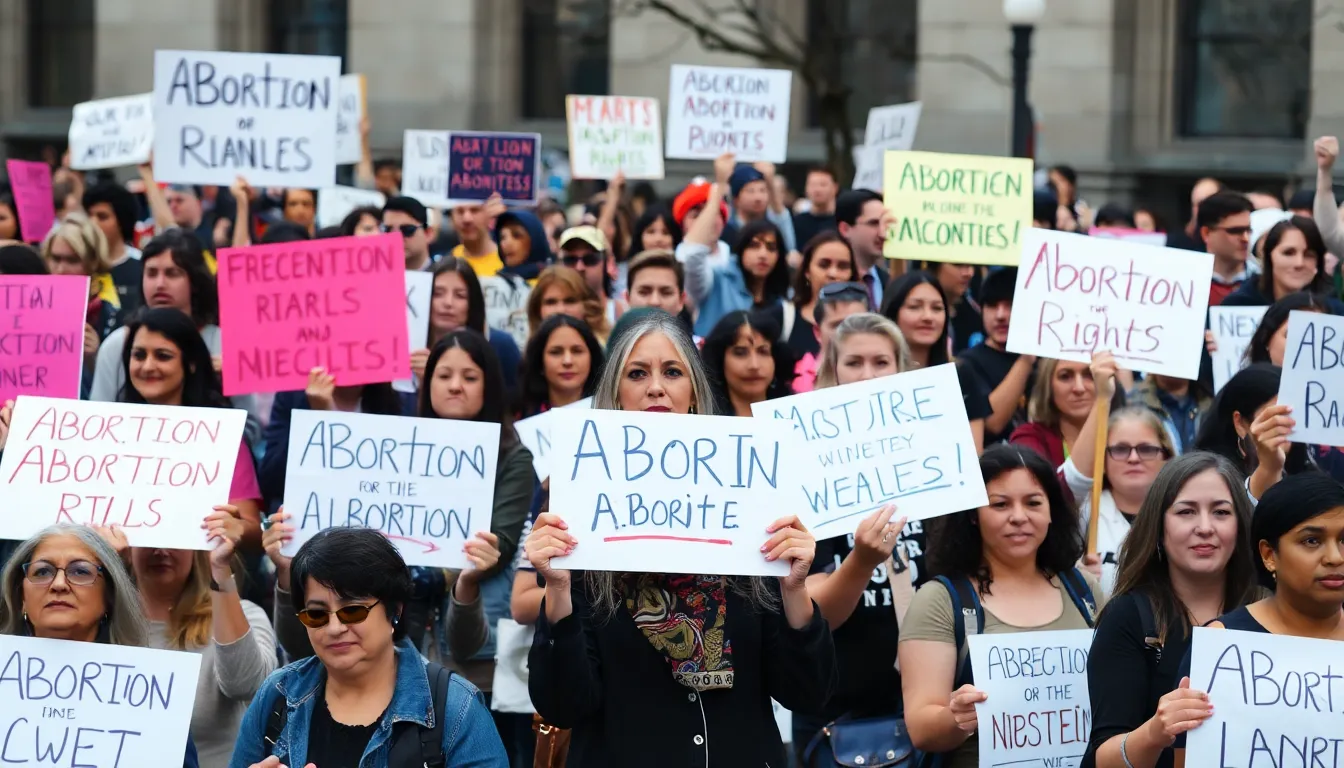The debate over Roe v. Wade has become a pivotal issue in American politics, especially during Donald Trump’s presidency. As the Supreme Court faced pressure from various factions, many wondered how Trump’s administration would influence the future of reproductive rights in the United States. The question of whether he could effectively overturn this landmark decision sparked intense discussions across the nation.
Trump’s nomination of three conservative justices to the Supreme Court raised hopes among his supporters that Roe v. Wade could be challenged. As the court’s composition shifted, the potential for significant legal changes loomed large. This article explores the impact of Trump’s presidency on Roe v. Wade and the broader implications for reproductive rights in America.
Table of Contents
ToggleBackground of Roe v. Wade
Roe v. Wade is a landmark Supreme Court decision issued on January 22, 1973. The case centered on an individual named “Jane Roe,” a pseudonym for Norma McCorvey, who challenged Texas laws criminalizing most abortions. The Supreme Court ruled that a woman’s right to choose to have an abortion fell within the constitutional right to privacy under the Due Process Clause of the 14th Amendment. This decision effectively legalized abortion across the United States, establishing a framework that balanced the state’s interests in regulating abortions with a woman’s right to privacy.
The ruling created a trimester framework regulating the extent of state involvement in abortion decisions. During the first trimester, the state could not regulate abortion; in the second trimester, states could impose restrictions related to maternal health; and in the third trimester, states could prohibit abortions except when necessary to protect the mother’s life or health. This framework established a legal precedent that influenced subsequent cases and legislative actions related to reproductive rights.
Over the years, Roe v. Wade faced numerous legal challenges and efforts aimed at overturning or undermining its provisions. Various states implemented laws that sought to limit access to abortions and placed restrictions on the procedure. Despite these challenges, Roe v. Wade remained a cornerstone of reproductive rights until significant changes in the Supreme Court’s composition shifted the landscape of reproductive health decisions.
Trump’s Stance on Abortion

Trump’s administration significantly influenced the abortion debate, particularly regarding Roe v. Wade. His approach to abortion reflected a commitment to conservative values, impacting national conversations on reproductive rights.
Campaign Promises
Trump made several campaign promises aimed at overturning Roe v. Wade. He pledged to appoint justices who would align with conservative judicial philosophies. His 2016 campaign highlighted support from anti-abortion groups, which viewed his presidency as a pivotal opportunity to challenge Roe v. Wade directly. Trump’s promises included appointing justices with records opposing abortion, motivating his supporters to rally for potential legal changes.
Policy Changes During Presidency
Trump enacted various policies affecting reproductive rights during his presidency. He reinstated the Mexico City Policy, restricting U.S. funding for international organizations that provide abortion services. Additionally, he supported the defunding of Planned Parenthood, advocating for redirecting federal funds to health clinics that do not perform abortions. Trump’s administration encouraged states to enact more restrictive laws, prompting numerous legal challenges aimed at Roe v. Wade. These actions generated significant legal and political discourse surrounding reproductive rights in the U.S.
The Supreme Court Dynamics
The dynamics of the Supreme Court shifted significantly during Donald Trump’s presidency, with his judicial appointments and related cases influencing the discussions around Roe v. Wade. These changes contributed to altering the legal landscape of reproductive rights in the United States.
Appointments Made by Trump
Trump appointed three justices to the Supreme Court: Neil Gorsuch, Brett Kavanaugh, and Amy Coney Barrett. These appointments solidified a conservative majority, shifting the ideological balance within the court. Gorsuch joined the bench in April 2017, followed by Kavanaugh in October 2018, and Barrett in October 2020. Their confirmations signaled a potential willingness to reconsider established precedents, including Roe v. Wade. This conservative majority prompted speculation about its readiness to hear cases challenging abortion rights and the framework established by Roe.
Key Cases Leading to Overturn
Several cases emerged during Trump’s presidency that posed direct challenges to Roe v. Wade. Notable cases include:
| Case Name | Year | Description |
|---|---|---|
| Whole Woman’s Health v. Hellerstedt | 2016 | Although decided before Trump took office, it set a precedent regarding the burden of abortion regulations. |
| June Medical Services v. Russo | 2020 | Addressed Louisiana’s abortion law requiring abortion providers to have admitting privileges at local hospitals. |
| Dobbs v. Jackson Women’s Health Organization | 2022 | Centered on Mississippi’s law banning most abortions after 15 weeks, challenging the viability standard set by Roe. |
These cases highlighted the court’s evolving approach to abortion regulations. Decisions in these cases provided insight into how the conservative majority might prioritize state rights and potentially reshape or overturn Roe v. Wade. Such pivotal rulings fostered intense public opinion and legal scrutiny, indicating a profound shift in reproductive rights litigation.
The Overturning of Roe v. Wade
The overturning of Roe v. Wade marks a significant turning point in U.S. reproductive rights. The decision has sparked widespread debate and legal actions that continue to evolve.
Who Initiated the Challenge?
Several states initiated challenges against Roe v. Wade during Trump’s presidency. Texas led the charge with its Senate Bill 8, effectively banning most abortions after six weeks. This law encouraged other states to adopt similar restrictive measures, contributing to a national wave of abortion legislation. Anti-abortion advocacy groups, including the Texas Right to Life, played critical roles in mobilizing support for these initiatives. Their actions signified broader efforts to weaken Roe v. Wade through direct legal challenges.
The Role of the Supreme Court
The Supreme Court’s composition shifted under Trump, significantly affecting its approach to abortion cases. Trump’s appointments of Neil Gorsuch, Brett Kavanaugh, and Amy Coney Barrett established a conservative majority that was more open to revisiting established precedents like Roe v. Wade. Key cases that came before the Court, such as Dobbs v. Jackson Women’s Health Organization, brought forth challenges that aligned with this new judicial philosophy. The Court’s ruling in Dobbs ultimately led to overturning Roe v. Wade, illustrating the profound influence of Trump-era judicial changes on reproductive rights in the U.S. The ruling dismantled the constitutional protections previously guaranteed, allowing states to impose their regulations without federal oversight.
Reactions and Implications
The response to the overturning of Roe v. Wade has been marked by widespread activism, political mobilization, and significant public discourse. Various groups, including reproductive rights advocates and anti-abortion organizations, expressed strong reactions, highlighting the profound implications for American society.
Public Response
Public response to the Dobbs v. Jackson Women’s Health Organization ruling manifested through protests, rallies, and organized campaigns. Activists against the decision have mobilized in major cities, advocating for reproductive rights and emphasizing the necessity of women’s autonomy. Conversely, anti-abortion advocates celebrated the ruling as a victory, viewing it as a restoration of state rights. Polls indicate that public sentiment remains divided, with many Americans voicing concerns about reduced access to reproductive healthcare services. As a result, discussions about reproductive rights have become central in political campaigns, with candidates aligning with public sentiments to secure votes.
Impact on Women’s Rights
The ruling’s immediate effects have raised significant concerns regarding women’s rights and healthcare access. States now possess the authority to establish their abortion regulations, leading to divergent laws across the country. In states like Texas, strict laws have been enacted, severely limiting access to abortion services. Conversely, some states have implemented protective measures to safeguard reproductive rights, creating a patchwork of regulations. Legal experts warn that this fragmentation may lead to increased health risks for women, particularly those in restrictive states. The decision has prompted discussions about social equity, underscoring how marginalized communities may face greater obstacles in accessing reproductive healthcare.
The impact of Donald Trump’s presidency on Roe v. Wade cannot be overstated. His appointments to the Supreme Court and the subsequent rulings have led to a dramatic shift in the landscape of reproductive rights in the United States. The overturning of Roe v. Wade marked a pivotal moment that continues to influence national conversations and legal battles surrounding abortion.
As states navigate their newfound powers to regulate abortion, the implications for women’s rights and healthcare access are profound. Activism and public discourse are likely to remain strong as various groups respond to the evolving legal framework. The future of reproductive rights is now more uncertain than ever, reflecting a deeply divided national sentiment on this critical issue.









